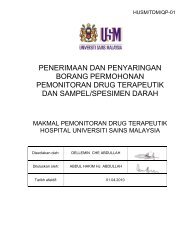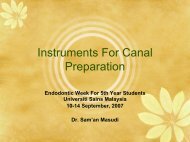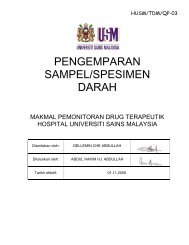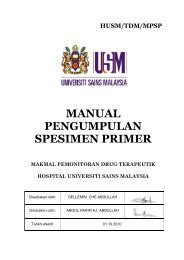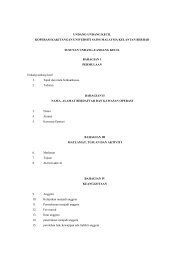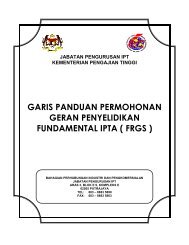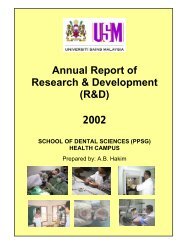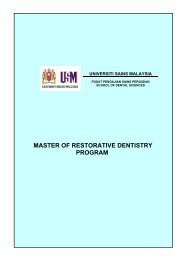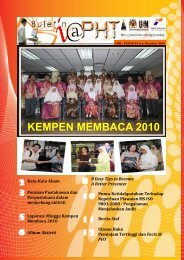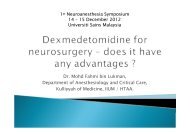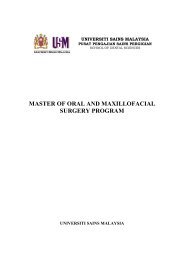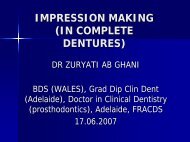Gingival Problems
Gingival Problems
Gingival Problems
Create successful ePaper yourself
Turn your PDF publications into a flip-book with our unique Google optimized e-Paper software.
<strong>Gingival</strong> <strong>Problems</strong><br />
Dr Erry Mochamad Arief<br />
Senior Lecturer in Periodontics<br />
13 Sept 2007
Contents<br />
Chronic gingivitis<br />
<strong>Gingival</strong> enlargement<br />
<strong>Gingival</strong> recession
Objectives<br />
To know the differential diagnosis of the<br />
various forms of gingivitis<br />
To describe etiology and treatment options for<br />
the various forms of gingival enlargement<br />
To describe appropriate therapy of gingivitis<br />
and gingival enlargement<br />
To explain etiology, clinical relevance and<br />
treatment for gingival recession
Healthy Periodontium<br />
•0 - 3 mm sulcus depth<br />
•No suppuration<br />
•No bleeding<br />
B C C T S S
Chronic Gingivitis
Clinical and histopathological feature of Chronic gingivitis<br />
Clinical<br />
feature<br />
Healthy<br />
Gingivitis<br />
Histopathology<br />
Fluid flow<br />
Minimal<br />
Increased<br />
Increased vascular permeability<br />
Bleeding on<br />
probing<br />
No<br />
Yes<br />
Vascularity increased<br />
Dilatation and engorgement of the capillaries<br />
Epithelium degenerated and thinned with capillaries<br />
closer to surface<br />
Color<br />
Pink<br />
Red to bluish red<br />
(erythema)<br />
Result of:<br />
Vascular proliferation<br />
Reduction of keratinization<br />
Venous statis cause bluish red<br />
Consistency<br />
Firm,<br />
resilient<br />
Soggy, puffy, pits<br />
on pressure<br />
(edema), flaccid<br />
Infiltration by fluid and cells into the inflamed region<br />
Flaccidity result of loss gingival fibers
Clinical and histopathological feature of Chronic gingivitis<br />
Clinical<br />
feature<br />
Healthy<br />
Gingivitis<br />
Histopathology<br />
Texture<br />
Stippling (not<br />
always)<br />
Loss of stippling,<br />
smooth and shiny<br />
Thinning or atrophy of the epithelium<br />
Degeneration associated with edema and<br />
leucocytic infiltration into the connective<br />
tissue<br />
Size<br />
Knife-edge edge margins<br />
Papilla fills<br />
intedental space<br />
Sulcus depth ≤ 3<br />
mm<br />
Swollen or<br />
balloning of<br />
interdental papilla<br />
and/or gingival<br />
margin<br />
False pocket<br />
formation<br />
Result of:<br />
Edema<br />
New capillary formation<br />
Vascular engorgement<br />
Shape/<br />
Contour<br />
Scalloped-troughs in<br />
marginal areas rise<br />
to peaks in<br />
interdental areas<br />
Blunts the marginal<br />
and papillary tissues<br />
Edema<br />
New capillary formation<br />
Vascular engorgement<br />
Remember B C C T S S
STIPPLING<br />
GINGIVAL MARGIN NOT STIPPLED
Distribution of gingivitis<br />
Localized ≤ 30%<br />
Generalized ≥ 30%<br />
Marginal<br />
Papillary<br />
Diffuse
Classification of Periodontal Diseases<br />
I. Diseases of the <strong>Gingival</strong> Unit: Gingivitis<br />
1- Plaque-induced gingivitis.<br />
2- Non-plaque-induced gingivitis<br />
II. Diseases of the Supporting Structures: Periodontitis
I. <strong>Gingival</strong> Diseases<br />
Dental plaque-induced gingival disease<br />
associated with dental plaque<br />
modified by systemic factors<br />
modified by medications<br />
modified by nutrition
Characteristics of Plaque-Induced Gingivitis<br />
Plaque present at gingival margin<br />
Disease begins at the gingival margin<br />
Change in gingival color<br />
Change in gingival shape/contour<br />
Sulcular temperature change
Characteristics of Plaque-Induced Gingivitis<br />
Increased gingival exudates<br />
Bleeding upon provocation<br />
Absence of attachment loss<br />
Absence of bone loss<br />
Histological changes<br />
Reversible with plaque removal<br />
Reversible with plaque removal
Characteristics of Plaque-Induced Gingivitis<br />
Microbial plaque is the DIRECT cause of gingivitis.<br />
Loe et al, 1965 study: (classic evidence)<br />
• 12 individuals Abstained from all oral hygiene measures.<br />
• All individuals developed gingivitis within 10-21 days.<br />
• All individuals returned to healthy gingiva within one week of<br />
resuming oral hygiene measures
Epidemiology gingivitis<br />
Is ubiquitous in population of children and adults<br />
globally<br />
>82% of adolescent in US have overt gingivitis and<br />
signs of gingival bleeding Albandar et.al, , 1996)<br />
Similar or higher prevalence in other parts of the<br />
world<br />
>75% of adults in US have gingival bleeding and<br />
dental calculus (Kingman and Albandar, , 2002)
Epidemiology CIPD: adults (MOH Malaysia, 1990, 2000)<br />
Periodontal Status 1990(%) 2000(%)<br />
Subjects examined having periodontal<br />
diseases<br />
92.8 90.2<br />
Gingivitis (CPITN 1) 4.6 4.2<br />
Calculus (CPITN 2) 65.1 56.9<br />
Moderate Pocketing (CPITN 3) 17 20.8<br />
Deep Pocketing (CPITN 4) 6.0 5.5<br />
Gingivitis (CPITN 1); Calculus (CPITN 2); Moderate pocketing (CPITN 3); Deep pocketing (CPITN 4)
I. <strong>Gingival</strong> Diseases<br />
Dental plaque-induced gingival disease<br />
associated with dental plaque<br />
modified by systemic factors<br />
• associated with endocrine system<br />
Puberty-associated gingivitis<br />
Pregnancy-associated:<br />
• gingivitis<br />
• pyogenic granuloma<br />
Diabetes mellitus-associated gingivitis<br />
• associated with blood dyscrasia<br />
leukemia-associated gingivitis<br />
modified by medications<br />
modified by nutrition
Puberty-associated gingivitis<br />
Clinical signs of gingivitis intensified.<br />
↑serum serum level of testosterone (boys) or estradiol<br />
(girls) results in:<br />
• ↑ level of Prevotela intermedia and P.<br />
nigrescens
Pregnancy-Associated Gingivitis<br />
↑ prevalence of gingivitis.<br />
Prevalence range 30-100%
Gingivitis Caused by Hormonal Changes<br />
Pregnancy<br />
Puberty<br />
REF: Color Atlas of Periodontology
Characteristics of Pregnancy-Associated<br />
Pyogenic Granuloma<br />
Plaque present at gingival margin<br />
Pronounced inflammatory response of gingiva<br />
Can occur anytime during pregnancy<br />
More common in maxilla<br />
More common interproximally<br />
Sessile or pedunculated protuberant mass<br />
Not a neoplasm; has histologic appearance of a pyogenic granuloma<br />
Regresses following parturition
Characteristics of Leukemia-<br />
Associated Gingivitis<br />
Pronounced inflammatory response of gingiva in relation to the plaque present;<br />
however, plaque is not a prerequisite for oral lesions<br />
<strong>Gingival</strong> lesions are primarily found in acute leukemias<br />
Change in gingival color<br />
Change in gingival contour with possible modification of gingival l size<br />
Enlargement first observed at the interdental papilla<br />
Bleeding upon provocation (may be one of the initial oral signs)<br />
Reductions in dental plaque can limit the severity of lesion
Characteristics of Diabetes<br />
Mellitus-Associated Gingivitis<br />
Plaque present at gingival margin<br />
Pronounced inflammatory response of gingiva<br />
Change in gingival color<br />
Change in gingival contour<br />
Increased gingival exudate<br />
Bleeding upon provocation<br />
Most commonly associated in children with poorly controlled Type-1 1 diabetes mellitus<br />
Absence of bone loss<br />
Absence of attachment loss<br />
Reversible with control of diabetic state<br />
Reduction of dental plaque can limit severity of lesion
(A) <strong>Gingival</strong> Diseases<br />
modified by medications<br />
• drug-influenced gingival enlargement<br />
• drug-influenced gingivitis:<br />
oral contraceptive-associated associated gingivitis
<strong>Gingival</strong> Disease Modified by<br />
Medications<br />
DRUG-INDUCED ENLARGEMENTS<br />
• dilantin, nifedipine, verpamil, cyclosporin<br />
• free gingiva increases in size and thickness<br />
• decrease in collagen turnover, increase<br />
interstitial ground substance
Characteristics of Drug-Influenced <strong>Gingival</strong><br />
Enlargement<br />
Variation in inter patient and intra patient pattern<br />
Predilection for anterior gingiva<br />
Higher prevalence in children<br />
Onset within 3 months<br />
Change in gingival contour leading to modification of gingival sizes<br />
Enlargement first observed at the interdental papilla<br />
Change in gingival color
Characteristics of Drug-Influenced <strong>Gingival</strong><br />
Enlargement<br />
Increased gingival exudate<br />
Bleeding upon provocation<br />
Found in gingiva with or without bone loss but is not associated<br />
with attachment loss<br />
Pronounced inflammatory response of gingiva in relation to the<br />
plaque present<br />
Reductions in dental plaque can limit the severity of lesion<br />
Must be using phenytoin, , cyclosporine A, or certain calcium<br />
channel blockers
<strong>Gingival</strong> enlargement<br />
Clinical conditions<br />
Clinical feature<br />
Histophatology<br />
Clinical enlargement<br />
(hyperplasia) associated with<br />
Dilantin (Phenytoin),<br />
Cyclosporine and Calcium<br />
Channel Blockers (Nefedipine(<br />
Nefedipine,<br />
Verapamil, Nitredipine,<br />
Felodipine, Diltiazem,<br />
Oxodipine<br />
Increased amount of gingival<br />
tissue, tissue usually<br />
firm<br />
Hyperplasia of<br />
connective tissue.<br />
Increased<br />
response of gingiva to<br />
plaque<br />
Pyogenic grauloma (pregnancy<br />
tumor) (gingivitis in pregnancy)<br />
Red, soft gingiva. . May be<br />
prominent enlargement<br />
interproximally<br />
Typical inflammatory<br />
response. Increased<br />
response of gingiva to<br />
plaque
<strong>Gingival</strong> enlargement in a patient taking phenytoin
Various forms of gingival enlargement
<strong>Gingival</strong> enlargement<br />
May be sign of an underlying systemic<br />
disorder<br />
A full medical history should always be taken<br />
Careful extraoral and intraoral examinations<br />
are necessary to determine the nature and<br />
extent of the lesion, additional signs and<br />
predisposing or traumatic factors.<br />
Referral to a specialist centre for additional<br />
investigations may be appropriate.
Chronic hyperplastic gingivitis<br />
Chronic hyperplastic gingivitis may occur following<br />
prolonged accumulation of dental plaque.<br />
It is frequently associated with concomitant systemic<br />
medications, though predisposing factors may not be<br />
identifiable. There is firm, pink gingiva, , enlargement,<br />
particularly at interdental sites, although an<br />
inflammatory component may also be present. The<br />
gingiva may partially cover the crowns of teeth,<br />
resulting in aesthetic problems and cleaning<br />
difficulties.<br />
Treatment: OHI, scaling and gingivectomy.
Epulides<br />
• Localised hyperplastic lesions arising from the<br />
gingiva.<br />
• Caused by trauma and chronic irritation from<br />
plaque and calculus invoke a chronic<br />
inflammatory response continued<br />
inflammation and repair occur concurrently <br />
excessive production of granulation tissue <br />
epulis.
Epulides<br />
Fibrous epulis<br />
Vascular epulis<br />
Peripheral giant cell granuloma
a) Fibrous epulis<br />
• firm, pink, pedunculated mass that may be<br />
ulcerated if traumatized.<br />
• histology: chronically inflamed, hyperplastic<br />
fibrous tissue which may be richly cellular or<br />
densely collagenous.<br />
• metaplastic bone and/or foci of dystrophic<br />
calcification are common.
) Vascular epulis<br />
• Include pyogenic granuloma and pregnancy<br />
epulis.<br />
• Characteristic : soft, purple/red swelling,<br />
frequently ulcerated which bleeds readily.<br />
• Histology : proliferation of richly vascular tissue<br />
supported by a fibrous stroma, , with a thin and<br />
often extensively ulcerated epithelium.<br />
• Pregnancy epulis occuring in pregnant women.
c) Peripheral giant cell granuloma (GCG)<br />
• Dark reddish/purple, ulcerated swelling, frequently<br />
arising interdentally and often extending buccally and<br />
lingually.<br />
• May cause superficial erosion of crestal alveolar bone.<br />
• Radiographs are essential to differentiate from a central<br />
GCG that has perforated the cortex to present as a<br />
peripheral swelling.<br />
• Histology : contains multiple foci of osteoclast-like like giant<br />
cells supported by a richly vascular and cellular stroma.
Treatment for epulides<br />
• Surgical excision.<br />
• Pregnancy epulis can be prevented by the<br />
removal of plaque and calculus, as well as OHI.<br />
• In pregnancy, surgical excision without complete<br />
elimination of local irritants, can be recurrence
Iatrogenic gingival enlargement<br />
• Denture induced enlargement<br />
• Orthodontically induced enlargement
Denture induced enlargement<br />
• chronic trauma from ill-fitting fitting dentures + poor<br />
OH hyperplasia of gingival tissues.<br />
• Sign: edematous, erythematous and bleed readily.<br />
• treatment : OHI, denture hygiene, SRP, and<br />
replacement of defective prostheses.
Orthodontically induced enlargement<br />
• results in the ‘heaping-up’ of gingival soft tissues<br />
in the direction of tooth movement.<br />
• More often with removal appliances<br />
• Resolve on completion of orthodontic treatment.<br />
• Treatment : OHI
Cystic lesions<br />
• <strong>Gingival</strong> cysts<br />
• Developmental lateral periodontal cysts
Cystic lesions<br />
<strong>Gingival</strong> cysts<br />
• < 1% of cysts of the jaws.<br />
• common in neonates, tend to resolve<br />
spontaneously in early life.<br />
• in adults, it is asymptomatic and found by chance<br />
in histological sections from gingivectomy<br />
specimens.<br />
• probably odontogenic in origin, arising from<br />
remnants of dental lamina.
Developmental lateral periodontal cysts<br />
• produces localized destruction of the periodontal tissues along a<br />
lateral root surface.<br />
• may present with expansion of alveolar bone, but most are<br />
incidental findings on radiographs.<br />
• resemble gingival cysts if arising near the alveolar bone crest.<br />
• radiographically, , appear as a radiolucency with well-defined bony<br />
margins.<br />
• Treatment for cystic lesions : surgical excision
Clinical and histopathologic feature of ANUG<br />
Clinical conditions<br />
Acute Necrotizing<br />
ulcerative gingivitis<br />
Clinical feature<br />
Fetid odor, painful<br />
gingiva, , sudden onset,<br />
punched-out<br />
interdental<br />
papillae, marginal and<br />
interdental papilla<br />
affected.<br />
Pseudomembranous<br />
slough. Local<br />
lymphadenopathy and<br />
slight elevation in<br />
temperature might be<br />
present<br />
Histophatology<br />
Surfaces epithelium degenerated<br />
and replace by pseudomembrane.<br />
The connective tissue is<br />
hyperemic with numerous<br />
capillaries and a dense infiltration<br />
of PMN. The layer between<br />
necrotic and living tissue contains<br />
numerous number of fusiform<br />
bacilli and spirochetes in addition<br />
to leucocyte<br />
Spirochetes has been show to<br />
invade the underlying living tissue
Necrotizing Ulcerative Gingivitis<br />
Pain and (spontaneous) bleeding<br />
Fetor exoris<br />
Punched out papillae<br />
Grey pseudo-membrane<br />
Fusospirochetal infection
Necrotizing Ulcerative Gingivitis<br />
Microbiology<br />
Fusobacterium sp. (spirochetes)<br />
Treponema sp.<br />
Porphyromonas gingivalis<br />
Prevotella intermedius
Necrotizing Ulcerative Gingivitis<br />
Secondary Etiology<br />
Impaired Chemotaxis<br />
Poor Oral Hygiene<br />
Alcohol<br />
Smoking<br />
Malnutrition<br />
Stress
Necrotizing Ulcerarive Gingivitis<br />
(Healing)
Non-plaque<br />
plaque-induced gingival lesions<br />
<strong>Gingival</strong> diseases of specific bacterial origin e.g N.gonorrhea ,<br />
T.pallidum and Streptococcal species<br />
<strong>Gingival</strong> diseases of viral origin e.g primary herpetic lesion,recurrent<br />
oral herpes ,vericella,<br />
vericella-zoster<br />
<strong>Gingival</strong> diseases of fungal origin e.g generalized gingival candidosis,<br />
linear gingival erythema, histoplasmosis<br />
<strong>Gingival</strong> lesion of genetic origin e.g hereditary gingival fibromatosis<br />
<strong>Gingival</strong> manifestations of systemic conditions e.g mucocutaneous<br />
disorders,allergic reactions to metals and dentifrices<br />
Traumatic lesions of chemical,physical, , and thermal origin<br />
Foreign body reaction<br />
Not otherwise specified (NOS)
Clinical and histopathologic feature of Acute Herpetic<br />
Gingivostomatitis<br />
Clinical conditions<br />
Acute Herpetic<br />
gingivostomatitis<br />
Clinical feature<br />
Involvement of gingiva and may<br />
include mucosa and lips. Appear<br />
vesicular, erythemathous, , shiny<br />
with varying degree of edema<br />
and gingival bleeding, After 24<br />
hours vesicles may rupture<br />
forming painful ulcers with a<br />
hello-like like margin and depressed<br />
grayish white central portion.<br />
More often in children with a<br />
duration on of 7-107<br />
days<br />
Histophatology<br />
Etiology-Herpes Simplex.<br />
Ulceration that result from<br />
rupture of vesicles<br />
resulting in a central<br />
portion of acute<br />
inflammation with<br />
purulent exudates<br />
surrounded by a zone rich<br />
a blood vessels
HIV-associated gingivitis<br />
Linear <strong>Gingival</strong> Erythema:<br />
• Persistent, linear, erythematous<br />
gingivitis.<br />
• Localized/generalized<br />
• Erythematous gingiva may be:<br />
Limited to marginal gingiva.<br />
Extend into attached gingiva and/or<br />
alveolar mucosa.
<strong>Gingival</strong> fibromatosis<br />
is an uncommon condition with autosomal dominant<br />
inheritance pattern.<br />
There is generalised fibrous enlargement of the<br />
gingiva as a result of the accumulation of bundles of<br />
collagen fibres.<br />
It is frequently associated with fibrous enlargement of<br />
the maxillary tuberosities.<br />
Treatment is usually not required, unless access for<br />
cleaning is impaired or aesthetics are compromised. It<br />
tends to recur following surgical excision.
Clinical and histopathologic feature of Desquamative<br />
Gingivitis and Pericoronitis<br />
Clinical conditions<br />
Clinical feature<br />
Histophatology<br />
Desquamative Gingivitis<br />
Intense redness and desquamation of<br />
the epithelium. Gingiva and mucosa<br />
involved<br />
Disruption of the epithelial-<br />
connective tissue with the<br />
formation of subepithelial<br />
bullae. . These lesions<br />
characteristically have<br />
immunoglobulins bound
Treatment for chronic gingivitis
Treatment<br />
THERAPEUTIC GOALS<br />
The therapeutic goal is to establish gingival<br />
health<br />
through the elimination of the etiologic factors:<br />
plaque, calculus, and other plaque-retentive<br />
factors
Treatment<br />
TREATMENT CONSIDERATIONS<br />
Contributing systemic risk factors may affect<br />
treatment and therapeutic outcomes for plaque-<br />
induced gingivitis. These may include diabetes,<br />
smoking, and certain periodontal bacteria, aging,<br />
gender, genetic predisposition, systemic diseases and<br />
conditions (immunosuppression(<br />
immunosuppression), stress, nutrition,<br />
pregnancy, substance abuse, HIV infection, and<br />
medications
Treatment<br />
A treatment plan for active therapy should be developed<br />
that may include the following:<br />
Patient education and customized oral hygiene<br />
instruction.<br />
Debridement of tooth surfaces to remove supra and<br />
subgingival plaque and calculus.<br />
Antimicrobial and antiplaque agents or devices may<br />
be used to augment the oral hygiene efforts of<br />
patients who are partially effective with traditional<br />
mechanical methods.
Treatment<br />
Correction of plaque-retentive factors such as over-contoured<br />
crowns, open and/or overhanging margins, narrow embrasure<br />
spaces, open contacts, ill-fitting fixed or removable partial<br />
dentures, caries, and tooth malposition.<br />
In selected cases, surgical correction of gingival<br />
deformities/enlargement that hinder the patient’s s ability to<br />
perform adequate plaque control may be indicated.<br />
Following the completion of active therapy, the patient’s<br />
condition should be evaluated to determine the course of future<br />
treatment.
Treatment<br />
Santos A: Evidence-based control of plaque<br />
and gingivitis. J Clin Periodontal 2003; 30<br />
(Suppl. 5): 13–16. Blackwell<br />
Munksgaard,2003.<br />
Click here<br />
to open the<br />
document
Treatment for gingival enlargement<br />
A strict programme of OHI and plaque control<br />
must be implemented. Overgrown tissues<br />
should be surgically excised
<strong>Gingival</strong> recession
POSITION<br />
Level of the gingival margin which is attached<br />
to the tooth<br />
Abnormality – gingival recession
GINGIVA RECESSION
GINGIVAL RECESSION<br />
Recession is exposure of the root surface by an<br />
apical shift in the position of the gingiva<br />
Actual position – level of the epithelial<br />
attachment on the tooth<br />
Apparent position – level of the crest of the<br />
gingival margin<br />
Severity of the recession is determined by the<br />
actual position not apparent position
APPARENT & ACTUAL LENGTH
ETIOLOGY<br />
Faulty tooth brushing technique (gingiva(<br />
abrasion)<br />
Tooth malposition<br />
Friction from soft tissue (gingiva(<br />
ablation)<br />
<strong>Gingival</strong> inflammation<br />
Abnormal frenum attachment<br />
Usage of a particular abrasive dentrifice
ETIOLOGY<br />
Traumatic incisor relationship<br />
Habits such as rubbing gingiva with a finger<br />
nail or end of a pencil<br />
Orthodontic movement in labial direction<br />
Smoking<br />
Aging - not due to physiological shift of the<br />
gingival epithelium but cumulative effect of<br />
minimal pathologic involvement
CLINICAL FEATURES<br />
Exposed root surface due to apical migration<br />
of the gingival complex<br />
Stillman’s cleft – an incipient lesion, a narrow,<br />
deep and slightly curved cleft extending<br />
apically from the free gingival margin<br />
McCall’s s festoon – rolled, thickened band of<br />
gingiva
STILLMAN’S S CLEFT & MCCALL’S<br />
FESTOON<br />
Stillman’s Cleft<br />
McCall’s festoon
PREDISPOSING FACTORS<br />
Natural defects in labial alveolar plates -<br />
Dehiscences (clefts) or fenestrations<br />
(windows)
CLINICAL SIGNIFICANCE<br />
Exposed root surface is susceptible to caries<br />
Abrasion or erosion of the cementum which<br />
subsequently cause hypersensitivity due to<br />
exposed dentinal tubules<br />
Hyperemia of the pulp<br />
Interproximal recession causes plaque<br />
accumulation
TREATMENT<br />
Record the magnitude of recession to assess<br />
progression or stability (clinically or on study<br />
models)<br />
Eliminate etiological factors<br />
Oral Hygiene Instruction<br />
Topical desensitising agent / flouride varnish<br />
<strong>Gingival</strong> veneer to cover exposed roots /<br />
embrasure spaces
TREATMENT<br />
Crown teeth with extreme caution to prevent<br />
exposure of coronal pulp at level of radicular<br />
preparation<br />
Mucogingival surgery to correct the recession<br />
either a lateral pedicle graft, double papilla<br />
flap or coronally repositioned flap<br />
Mucogingival surgery to provide a wider and<br />
functional zone of attached gingiva using free<br />
gingiva flap
MUCOGINGIVAL SURGERY<br />
USING FREE GINGIVAL FLAP<br />
BEFORE<br />
AFTER
REFERENCES<br />
Newman Takei Carranza, Carranza’s Clinical<br />
Periodontology, , 2003;15-33, 33, 275-277<br />
277<br />
Peter Heasmen, , Master Dentistry – Restorative<br />
Dentistry, Paediatric Dentistry and<br />
Orthodontics



